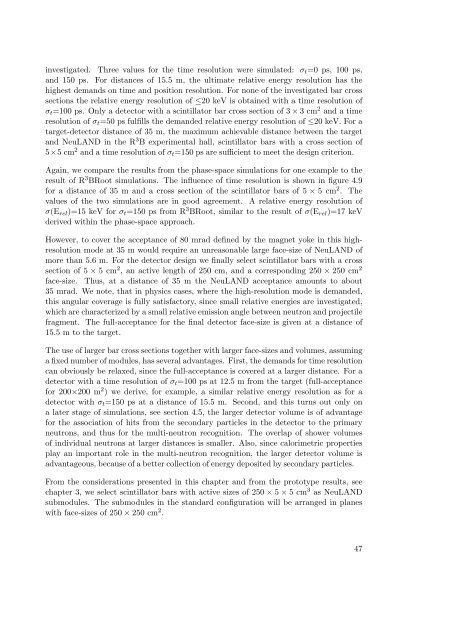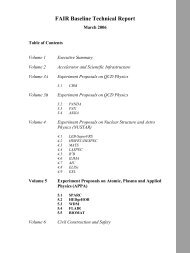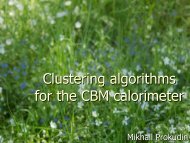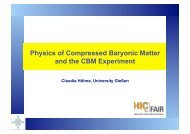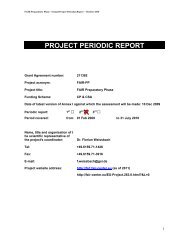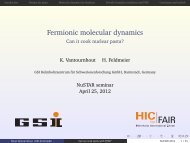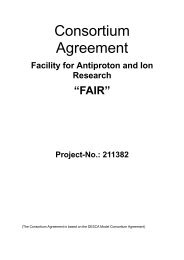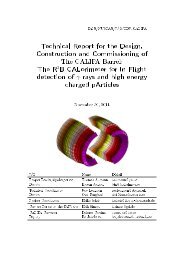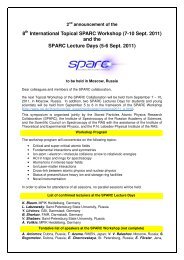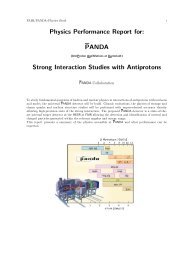NeuLAND - FAIR
NeuLAND - FAIR
NeuLAND - FAIR
Create successful ePaper yourself
Turn your PDF publications into a flip-book with our unique Google optimized e-Paper software.
investigated. Three values for the time resolution were simulated: σt=0 ps, 100 ps,<br />
and 150 ps. For distances of 15.5 m, the ultimate relative energy resolution has the<br />
highest demands on time and position resolution. For none of the investigated bar cross<br />
sections the relative energy resolution of ≤20 keV is obtained with a time resolution of<br />
σt=100 ps. Only a detector with a scintillator bar cross section of 3 × 3 cm 2 and a time<br />
resolution of σt=50 ps fulfills the demanded relative energy resolution of ≤20 keV. For a<br />
target-detector distance of 35 m, the maximum achievable distance between the target<br />
and <strong>NeuLAND</strong> in the R 3 B experimental hall, scintillator bars with a cross section of<br />
5×5 cm 2 and a time resolution of σt=150 ps are sufficient to meet the design criterion.<br />
Again, we compare the results from the phase-space simulations for one example to the<br />
result of R 3 BRoot simulations. The influence of time resolution is shown in figure 4.9<br />
for a distance of 35 m and a cross section of the scintillator bars of 5 × 5 cm 2 . The<br />
values of the two simulations are in good agreement. A relative energy resolution of<br />
σ(Erel)=15 keV for σt=150 ps from R 3 BRoot, similar to the result of σ(Erel)=17 keV<br />
derived within the phase-space approach.<br />
However, to cover the acceptance of 80 mrad defined by the magnet yoke in this highresolution<br />
mode at 35 m would require an unreasonable large face-size of <strong>NeuLAND</strong> of<br />
more than 5.6 m. For the detector design we finally select scintillator bars with a cross<br />
section of 5 × 5 cm 2 , an active length of 250 cm, and a corresponding 250 × 250 cm 2<br />
face-size. Thus, at a distance of 35 m the <strong>NeuLAND</strong> acceptance amounts to about<br />
35 mrad. We note, that in physics cases, where the high-resolution mode is demanded,<br />
this angular coverage is fully satisfactory, since small relative energies are investigated,<br />
which are characterized by a small relative emission angle between neutron and projectile<br />
fragment. The full-acceptance for the final detector face-size is given at a distance of<br />
15.5 m to the target.<br />
The use of larger bar cross sections together with larger face-sizes and volumes, assuming<br />
a fixed number of modules, has several advantages. First, the demands for time resolution<br />
can obviously be relaxed, since the full-acceptance is covered at a larger distance. For a<br />
detector with a time resolution of σt=100 ps at 12.5 m from the target (full-acceptance<br />
for 200×200 m 2 ) we derive, for example, a similar relative energy resolution as for a<br />
detector with σt=150 ps at a distance of 15.5 m. Second, and this turns out only on<br />
a later stage of simulations, see section 4.5, the larger detector volume is of advantage<br />
for the association of hits from the secondary particles in the detector to the primary<br />
neutrons, and thus for the multi-neutron recognition. The overlap of shower volumes<br />
of individual neutrons at larger distances is smaller. Also, since calorimetric properties<br />
play an important role in the multi-neutron recognition, the larger detector volume is<br />
advantageous, because of a better collection of energy deposited by secondary particles.<br />
From the considerations presented in this chapter and from the prototype results, see<br />
chapter 3, we select scintillator bars with active sizes of 250 × 5 × 5 cm 3 as <strong>NeuLAND</strong><br />
submodules. The submodules in the standard configuration will be arranged in planes<br />
with face-sizes of 250 × 250 cm 2 .<br />
47


